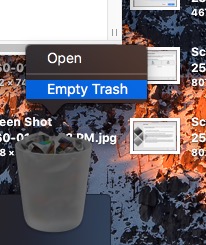

The second thing you can try is “Secure Empty Trash.” Hold down the Command key while pressing the Right Mouse Button, and Empty Trash on the popup menu will turn into Secure Empty Trash. But if it doesn’t, you have to get more creative. Nothing else you try to do to the file will work. You have to eject or unmount the drive before you can delete the file.

Note: A common problem is that a file you are trying to delete was actually from an open DMG disk image file. The way to make sure (and the first thing to check when this happens) is to close all other programs other than Finder and try emptying the trash again. Sometimes this can be as tenuous as a link to the file being in the recent files list in the program concerned. Sometimes, despite your false impression the file is done with, it is actually still “in use,” that is to say referenced by a program that is still running. In this article we will be discussing the variety of ways you can get around this annoying message, empty the trash, and get on with your day.

But often the file is not in use, you know it isn’t and yet the message is stubbornly persistent. Frustrating isn’t it?Īround seven times out of ten, the file is actually linked to a program, and there is a legitimate reason for this annoying message. To do it from any open Finder window, click on the Finder menu and select Secure Empty Trash.īonus Tip: Make Secure Empty Trash the default behaviorUse this tip if you'd like to make sure that your Mac securely deletes files every time you empty the Trash.We’ve all had it, that time when you try to empty your trash in OS X and the system tells you it can’t delete the files because they are “in use,” when as far as you are aware, they’re not.Empty Trash will change to Secure Empty Trash. Hold down the command key and click on the Trash.Click and hold on the Trashcan icon in the Dock.Secure Empty Trash takes longer, but provides, as the name implies, a more secure form of file deletion.

Secure Empty Trash overwrites the deleted files with what Apple calls "meaningless data." Sometimes you may delete files that are particularly sensitive: Financial records, for example, intimate photos, or other data you absolutely don't want anyone to get their hands on, under any circumstances.Īpple has considered this and has provided a Secure Empty Trash option as well. As a result, some deleted files can be recovered using disk recovery software. But emptying the trash doesn't really destroy the files: They remain on the hard drive, marked for being overwritten the next time your Mac needs the space. How to securely empty the trash on your MacEmptying the trash is usually sufficient to get rid of the files you don't want anymore.


 0 kommentar(er)
0 kommentar(er)
